Excerpts from Jim Conrad's
Naturalist Newsletter
from the July 2, 2017 Newsletter issued from Rancho Regenesis in the woods ±4kms west of Ek Balam Ruins; elevation ~40m (~130 ft), N20.876°, W88.170°; north-central Yucatán, MÉXICO
OKRA
In our organic garden my okra also is doing well, though its leaves are bug-eaten. Below, you can see a waist-high plant:
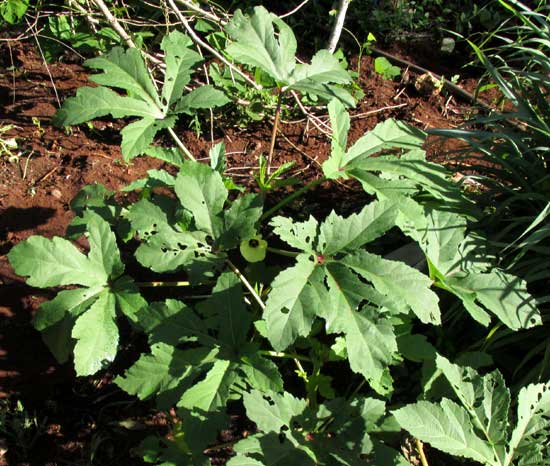
Okra's flowers are exceptionally large and pretty, as you can see below:
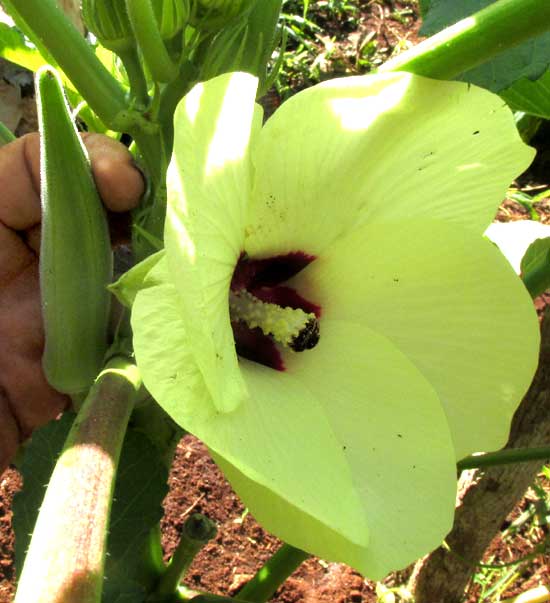
In that picture, notice my fingers wrapped around a hairy okra fruit perfect for plucking. The fruit pods grow to a foot long or so, but at that size they're too woody to eat. When picked at the size in the picture they're so tender that they can be munched on raw. Okra tastes good to some people, but not so good to others, plus many can't stand its somewhat slimy texture. I like it in all its permutations, from super slimy go to crisp-fried, and it's good raw, too, a perfect snack while sweating in the garden.
There's a good reason okra's flowers look like hibiscus blossoms: Okra belongs to the Hibiscus Family, the Malvaceae, and in the old days was even placed in the genus Hibiscus, as Hibiscus abelmoschus. Nowadays usually it's listed as ABELMOSCHUS ESCULENTUS.
One of the prime field marks for flowers of the Hibiscus Family is that its stamens join one another at the bases of their filaments, often forming a cylindrical "staminal column" surrounding the pistil's stigma-tipped style. Below, you can see this configuration in the okra's flower
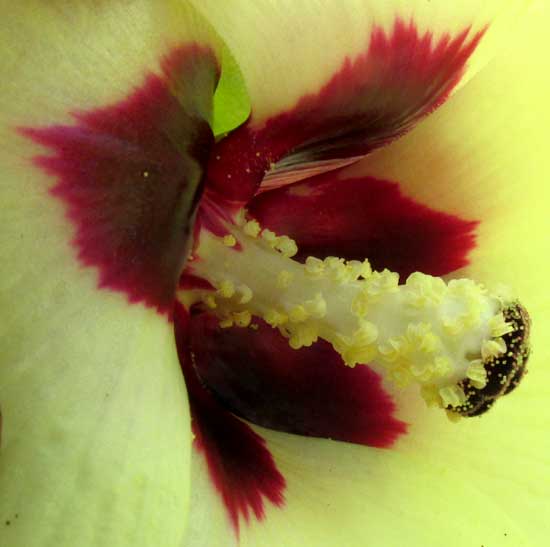
In that picture, the whitish, ±horizontal item is the staminal column. On the column's surface the grainy, yellowish things are the stamens' pollen-producing anthers. The dark item at the far right is the stigma, dusted with yellow grains of pollen. The pollen grains will germinate and send down microscopically thin tubes conducting the male sex germ all the way down the style within the staminal column, to ovules inside the ovary at the flower's bottom.
It's not too surprising that okra would do well here because okra is thought to have originated in hot areas of Africa or southern Asia. Its genetics is fairly kinky. It's an "allopolyploid" whose genes have been gathered from three or more completely different species of parents. No wild okra species are known to exist. The first report of okra pods being eaten are from Egypt in 1216. It was introduced into the Americas by ships carrying slaves from Africa.
Okra is a perennial plant, though up North it's grown as an annual. I may let our garden's plants keep growing as long as they want, just to see how tall they get. The Wikipedia expert says they grow up to 6.6ft tall (2m) but even in Kentucky I've grown them taller than that.
from the April 14, 2008 Newsletter written in the community of 28 de Junio, in the Central Valley, 8 kms east of Pujiltic, Chiapas, MÉXICO
OKRA SEEDS AS "COFFEE"
Last Friday I was hiking through the Tzotzil-speaking higher outskirts of Venustiano Carranza with Andrés' brother Don Sebastián when I espied the weather-bleached, past-prime, very familiar plant seen below:

I've seldom seen okra, or gumbo, ABELMOSCHUS ESCULENTUS, growing down here, but here it was, the plants a gangly ten feet tall and the fruit pods in the process of splitting to release BB-sized seeds. There was no evidence of any of the pods having been cut earlier for eating.
Okra was introduced into the Americas from Africa so I wondered what name Tzotzil-speaking Sebastián might have for it. I was hoping for a Tzotzilized name rooted in either the words okra or gumbo, which I imagined might be of African origin.
"Café," replied Don Sebastián. "Roast the seeds, grind them up, and you get coffee."
Don Sebastián showed every indication that he didn't believe my assertion that immature okra pods collected when they're about 1.5 inches long and snipped into a stew improve its flavor and even that properly fried and eaten with fresh-from-the-garden tomatoes they can be absolutely delicious.
"Café," he repeated. "This plant provides a drink, not food."
issued June 26, 2021 from the Dry Frio River Valley in northern Uvalde County, southwestern Texas, on the southern border of the Edwards Plateau, USA
ANTS FEEDING ON OKRA FLOWER CALYXES
Often I've noticed what's seen below, both here and in other places:
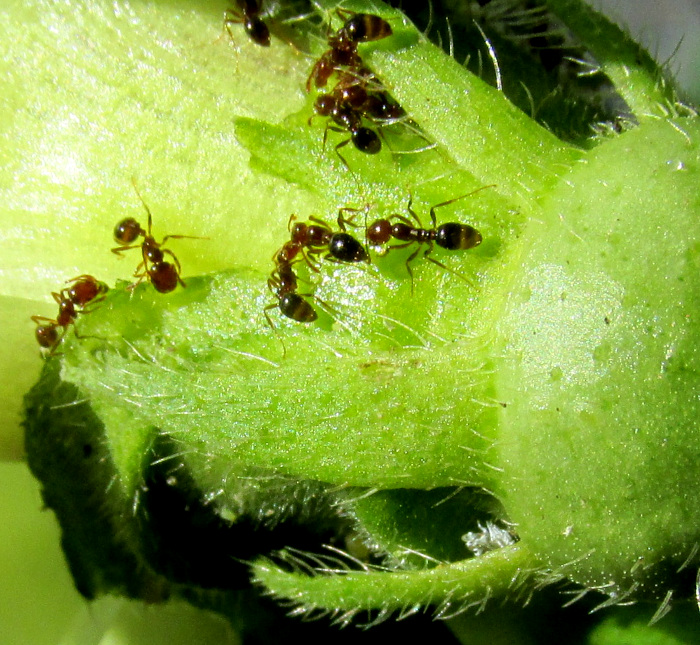
It's well documented that many plants produce glands that offer nectar or some other kind of inducement to ants. When the glands are on the sepals of blossoms, it's assumed that the ants form a barrier to caterpillars and other organisms who might climb up the plant, go the flower, and begin eating the sexual parts, thus damaging or destroying the flower's reproductive capacity. I can't find mention of this in papers available on the Internet, so I'll just park this information and picture here, and maybe a researcher someday will be glad to find it.
from the September 19, 2017 Newsletter issued from Rancho Regenesis in the woods ±4kms west of Ek Balam Ruins; elevation ~40m (~130 ft), N20.876°, W88.170°; north-central Yucatán, MÉXICO
NEMATODES ON OKRA ROOTS
Now I don't think my okra plants will ever reach the height I thought we'd see. Leaves on many of my plants are dying. Below, you can see what I saw on the roots when I pulled up a completely dead Okra plant:
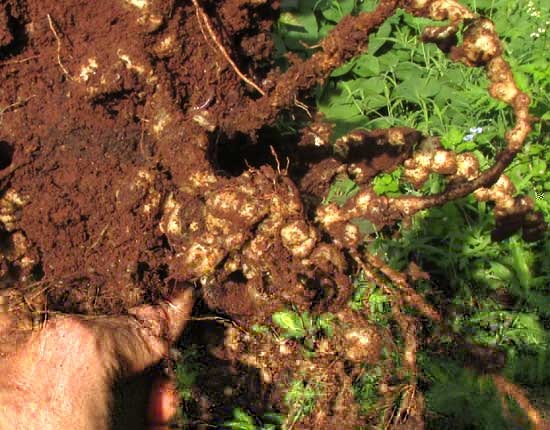
We've already seen knotty growths like that on dead and dying tomato plants, at www.backyardnature.net/yucatan/nematode.htm
The growths are caused by nematodes, which are microscopic roundworms living in the soil and attacking plant roots. A page entitled "Nematode Management in Okra" presented by the University of Florida IFAS Extension service, says "Okra is infamous for its susceptibility to root-knot nematodes; it is also extremely sensitive to sting nematodes. Because of this, okra should not be planted in land known to have severe problems with these nematodes in recent crops."
We've already seen that the rancho's soil is so rich in nematodes that they killed my entire pepper crop, which consisted of five different chili varieties, as well as my cucumbers and Zucchini. I had similar nematode problems at Chichén Itzá. With time I'm seeing that nematodes are very important to consider when gardening in the Yucatan. The best measure against them is to enrich the soil with organic matter.